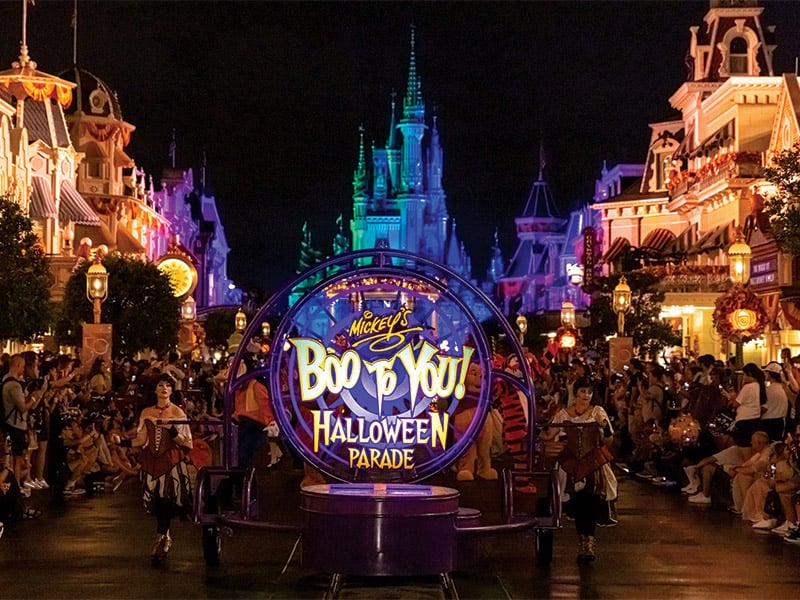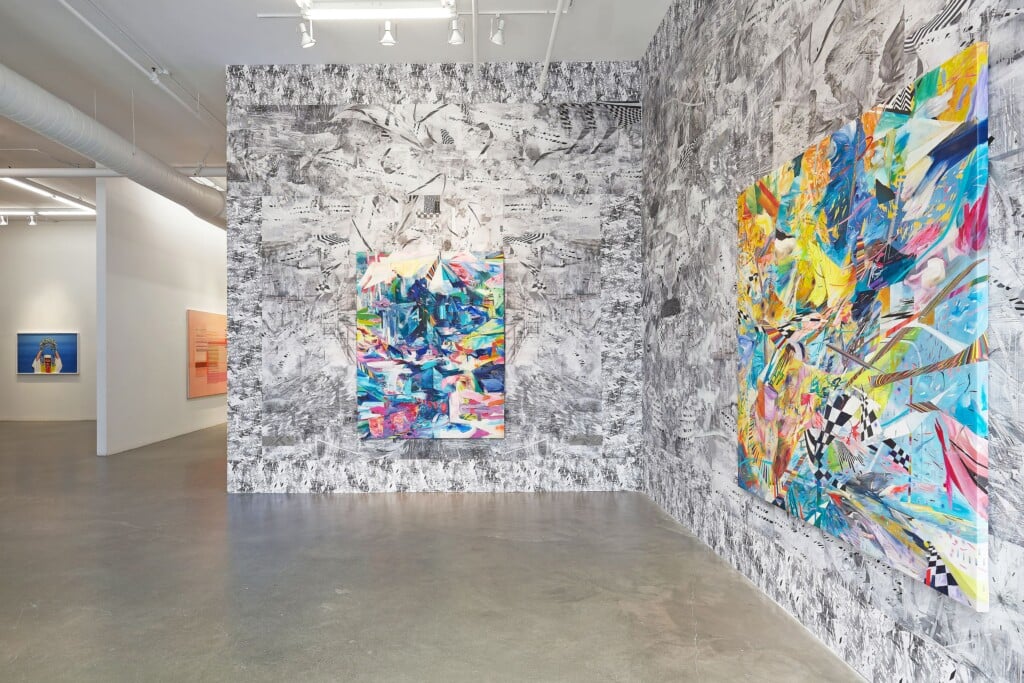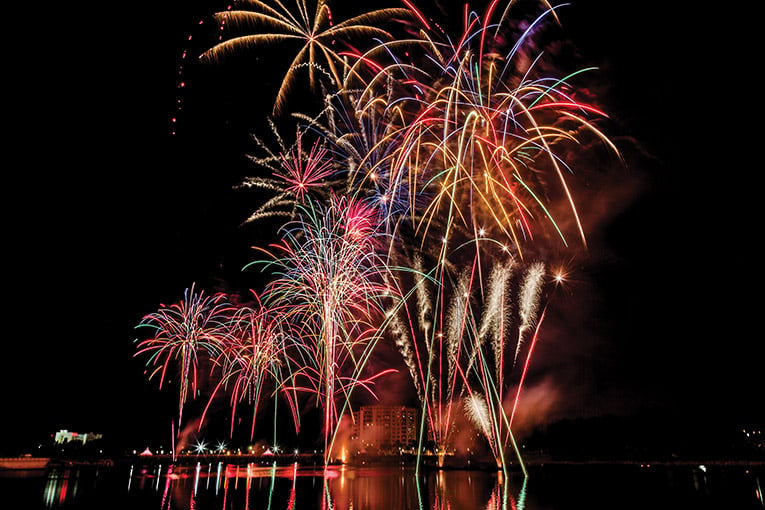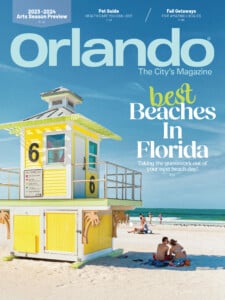Orlando Arts Season Preview 2022 – 2023
A Renaissance, for Real
While the 2021 season ushered in a comeback for the arts scene in Orlando, it was a valiant effort but tentative due to the aftermath of the pandemic. The upcoming 2022 season is much more robust. It’s clear there’s no holding back the wave of creativity that was bubbling under the surface during the shutdown. As we walk through the innovative and imaginative shows and events scheduled for the upcoming season, we’re sure you’ll agree that Orlando is experiencing a renaissance. This time, it’s for real.
Broadway by the Numbers
It’s not like season ticket holders earn three credit hours towards a degree. But there’s a history-major vibe to the Fairwinds Broadway in Orlando series at the Dr. Phillips Center for the Performing Arts this season, starting with “Six, the Musical,” which stars Henry VIII’s half-dozen wives, three of whom were dismissed, two of whom were beheaded, and one who–you go, girl–outlived the royal pain.
The queenly sextet is theatrically reincarnated in “Six” as a modern-day singing group with a Spice Girls vibe. In this hit Broadway musical, they choose their lead singer via a concert/contest, with each performer staging a number designed to make the case that Henry gave her the worst treatment. You might expect the, um, edge to favor the two who had their heads chopped off, meaning Anne Boleyn and Catherine Howard. But don’t think Boleyn, think Beyonce, and don’t think Anne, think Adele.
This is not your grandmother’s costume drama. Created by Cambridge University students Toby Marlow and Lucy Moss and first presented at the Edinburgh Fringe Festival in 2017, the show crossed the pond to debut in Chicago in 2019. It took up residence at the Brooks Atkins Theater in New York City last year.
Among other regular-season offerings in the Broadway series, Harper Lee’s “To Kill a Mockingbird,” the stage version of that cherished 1960 novel, will get a sentimental boost via the presence of Richard Thomas, who played John Boy in the beloved 70s television series The Waltons. He’ll portray defense lawyer Atticus Finch in the coming-of-age courtroom drama tinged with Depression-era racism in a small southern town. Other regular season shows: “Chicago,” “My Fair Lady,” “Pretty Woman: The Musical,” a raucous stage reincarnation of an 80s movie in “Beetlejuice,” and “Tina: The Tina Turner Musical.” As for that history-class vibe, it gets a boost from the return of “Hamilton” offered as an optional “plus one” to the regular season. drphillipscenter.org
Magic Show
It has been sampled by a Finnish melodic death metal band, on the one hand, inspiring the theme music of the Canadian national anthem on the other. It has been staged or filmed featuring hippies in a commune, soldiers on a battlefield during World War I, astronauts on the moon, the Smurfs, characters, and scenery based on Maurice Sendak’s iconic “Where the Wild Things Are,” and gunslingers in a western town.
Everybody wants to take a shot at the uber opera. You may now add the folks at Opera Orlando to the list.
Their late October performances at the Dr. Phillips Center’s Steinmetz Hall of “The Magic Flute,” with music created by Wolfgang Amadeus Mozart almost three centuries ago for a libretto written by his close friend, Emanuel Schikaneder, will represent a coming-of-age moment for the ambitious, six-year-old company.
“It’s our way of affirming that we’re here to stay,” says artistic director Gabe Preisser. “It connects with our slogan: ‘Opera Everlasting.’”
If ever an opera were made to last forever, it would be this one, featuring a prince accompanied by a goofy sidekick who must face a series of challenges concocted by a duplicitous queen, all of it to rescue a princess while being pursued by a giant serpent. Like its musical creator, the opera is both childlike and sublime, having blended fairy-tale conventions, hints at the progressive political nuances of Mozart’s day, and ethereal music punctuated by one of opera’s most cherished, challenging arias.
Look no further for evidence of its global appeal than Opera Orlando’s guest director, Chaowen Ting, who grew up in Taiwan and saw it in the country’s only opera house as a child. She remembers a scary balloon serpent and dialogue being spoken, as is the tradition wherever “The Magic Flute” is staged in the vernacular (in this case, Mandarin) while its music was sung (haltingly, as Ting recalls it) in original German.
Similarly, the Opera Orlando production will be sung in German, with translation flashed on a screen, while the dialogue will be in English. The dragon and other creatures will be puppets, created locally by Michelle Puppets and inspired by the artistry of Yoshitaka Amano, who created the artwork for “Final Fantasy.”
Says Preisser: “Who doesn’t love puppets? And who doesn’t love Mozart?” operaorlando.org
Do-Over for a Diva
Yuja Wang encountered a chilly reception on her first visit to Orlando: not exactly what you’re looking for when your city hosts one of the greatest pianists in the world. This was in January 2021. They had planned for the glamourous New York City virtuoso to appear as a guest soloist with the Orlando Philharmonic Orchestra at Steinmetz Hall, the new, state-of-the-art, $240 million acoustic theater at the Dr. Phillips Center for the Performing Arts. The performance that was scheduled for her was one that only a handful of living pianists would even attempt: three monumental Rachmaninoff concertos.
But because of construction delays, the hall wasn’t available, and because of pandemic restrictions, neither was any other indoor venue. Wang handled it like a pro, switching from Rachmaninoff to Brahms, setting aside her legendary fashionista ways in favor of sensibly bundling up and flashed her street creds as a trouper by gamely playing outdoors in a stadium as temps dipped into the mid-40s.
The good news is she’s coming back; better yet, in springtime. She’ll bring her visceral affinity for Rachmaninoff with her (“I have that blood,” as she once put it) for a return engagement with the Phil, slated for March 4 and 5, at the since-completed Steinmetz Hall.
It’s a concert that represents a cultural watermark for Orlando. Having a generational virtuoso with her command of technique and interpretation play the vaunted new hall with its pin-drop acoustics is the equivalent of flying in a top-gun pilot to show every gawker on the tarmac just what the latest prototype can do. Wang’s primed for the occasion, having chosen two challenging Rachmaninoff masterpieces for the concert. She has selected the devilish Rhapsody on a Theme of Paganini and the incorrigibly romantic Piano Concerto No. 1. Get your tickets early. I’m just sayin’. orlandophil.org
The Art of Immortality
Four and half centuries ago, knowing he was nearing the end of his life, the alpha Renaissance man, one of the greatest artists who ever lived, gathered as many of his drawings as he could and burned them together. Exactly why Michelangelo did that has been a subject of debate ever since.
Fortunately, many of his cherished drawings were in possession of others and survived. One of their largest collections is at the Casa Buonarroti Museum in Florence, housed in a palazzo that Michelangelo owned but left behind when he moved to Rome. “Sacred and Profane,” an exhibit of 26 drawings that have been touring the United States for the past ten years, will open at the Orlando Museum of Art during the 2022-2023 season.
“Profane,” in this sense, refers to the imperfection of earthly things as opposed to the sacred sublimity of the spiritual world. Michelangelo spent his life in a visual exploration of those eternal opposites. One of the best-known drawings in the exhibit combines the two, with a serene, stunningly beautiful image of Cleopatra as an earthly goddess on one side and a tortured visage of her as a frightened, clearly mortal woman on the other. Michelangelo also created elaborate architectural drawings. The exhibit will showcase 14 of them, depicting designs for churches, military fortifications, a library, and an ornate gateway.
It’s painful to imagine how many lost creations disappeared in his late-life bonfires. Why did he destroy them? The simplest explanation comes from a friend and fellow artist named Giorgio Vasari. He believed that Michelangelo, having sought perfection all his life, didn’t want people to know how hard he had to work to achieve his artistic wizardry. Perhaps it was his way of drawing a curtain between himself and his work, mutely advising those who looked to the spiritual splendor of his masterpieces for guidance to pay no attention to that man behind the curtain. omart.org
Life Imitates Art
Maybe it’s just a coincidence. Perhaps somebody at Orlando Shakes has a keen sense of irony. One way or the other, you can’t help but smile at the choice for the company’s season opener: “Noises Off,” the prototypical Play-Where-Everything-Goes-Wrong about a theatrical troupe’s struggle to contend with one disaster after another.
Sounds a bit like the Shakes’ own struggles over the past two seasons.
The problems weren’t self-inflicted, as in “Noises Off,” but were forced upon the company, first by the reality and then by the ebbing aftermath of the Covid pandemic. The good news is that all signs, large and small, point to 2022-23 as a full-fledged comeback season.
After being suspended for two years, the children’s series is being reinstated. “Just hearing children’s laughter again is going to be a wonderful thing,” says Shakes artistic director Jim Helsinger, who’s also bringing back the Shake’s adaptation of “A Christmas Carol,” this time with a reassuring resolve to make it an annual tradition. “People like traditions,” he says.
People like seeing a familiar face, too. Orlando Fringe devotees will be happy to see that Tymisha Harris, who has starred in two Fringe shows devoted to Josephine Baker, makes her Shakes debut. She’ll portray that American-born French dancer and civil rights activist in “Lady Day at Emerson’s Bar and Grill.” Set in a run-down bar in South Philadelphia in 1959, it brings a melancholy Holiday to life during one of her last performances.
More tradition: “The Fire and Reign” series, tracking Shakespeare’s cycle of dramas based on events of the 100-year-war between England and France, continues with “Henry V.” Finally, with a nod to Shakes loyalists who have been requesting it for years, the company will finish the season in style with “Kinky Boots.” The 2012 Harvey Fierstein musical, based on a true story, tells the tale of a struggling British shoe factory whose owner forms an unlikely partnership with a drag queen to save the business. orlandoshakes.org
Abby’s Road
Here’s an April 1960 entry, dateline, Katmandu, in the diary of a solitary tourist–a determined Midwestern widow named Abby Weed Grey:
“My usual feelers were out, trying to find artists. Other travelers might have been suspicious or reluctant to follow the advice of a hotel clerk, but this was my only lead, and I felt a good one. If I went to the universities and asked for their advice, I was given lists of those who emphasized the academic style espoused by those institutions. I wanted the new.”
She wanted it and found it, single-handedly compiling a remarkable trove of cutting-edge modern art in Asia and the Middle East. When, as far as the reigning experts and institutions were concerned, nothing of much importance regarding progressive contemporary artistry happened outside the borders of Europe and the United States.
Grey, who had no advanced art education, was discovering otherwise. Born in St. Paul, Minnesota, in 1902, she was an independent and adventurous Vassar College graduate who, seeking a sense of purpose after the death of her husband in 1956, set out on several tours, most of them solitary, to Iran, Turkey, Thailand, India, and the Orient. Eventually, she parlayed part of the fortune the couple had amassed in investments into a collection of 700 works that mirrored the modern stylistic evolution reflected by breakaway artists elsewhere in the globe while still reflecting the sensibilities and heritage of their native lands.
Grey spent decades catching up to the world at large. It took the world at home longer to catch up to her. When she offered her collection to her hometown’s university, they couldn’t accommodate her. She finally found a place for it at New York University. But even NYC took its time acknowledging the significance of her single-handed question and her contribution to a global understanding of modernist art: When she died in 1980, the obituary in The New York Times was only four paragraphs long.
In the years since, Grey has been given her due. “All the experts were looking the other way,” says Ena Heller, director of the Rollins Museum of Art, focusing on multicultural modernism. “She had a different view.”
A touring exhibit featuring several key works from Grey’s collection opens this month at the museum, on loan for four months from New York University’s Grey Art Gallery. It features works from Iran, India, and Turkey, along with correspondence, journals, invoices, exhibition brochures, invitations, and photographs from the Abby Weed Grey Papers housed in the NYU Archives. rollins.edu/rma
A Different Desire
Most tweeners who discover “The Hobbit” are happy just getting carried away by J. R. R. Tolkien’s fantasy about a pipe-smoking burrow dweller who battles with assorted goblins and a miserly dragon named Smaug. Jorden Morris wanted to take it a step further. Make that several steps.
“I was 12 when I read it,” he says. “And what I wanted to do was to turn it into a ballet.”
It may happen yet. Morris was a former principal dancer at Canada’s Royal Winnipeg Ballet and the new artistic director of Orlando Ballet. He has crafted narrative ballets about “Moulin Rouge,” the bohemian 19th-century Parisian cabaret where the cancan was invented, and “The Great Gatsby,” F. Scott Fitzgerald’s 1925 Jazz Age novel about a doomed Roaring Twenties idealist.
Both will be presented as part of the company’s season, along with three other narrative ballets: the traditional Christmas favorite, “The Nutcracker,” and Michael Pink’s elegantly haunting “Dracula,” which will be timed, naturally, to celebrate a somewhat spookier holiday. But the addition of yet another ballet to the season makes it clear just how seriously committed Morris is to be exploring and celebrating narrative in dance.
That ballet is Anna Lopez Ochoa’s impassioned, courageously reimagined “A Streetcar Named Desire,” based on Tennessee Williams’s Pulitzer Prize-winning 1947 play. The play revolves around Blanche Dubois, an alcoholic, mentally unstable Southern belle desperate to escape her past, visiting her sister and her thuggish husband in New Orleans. Blanche is rendered with little, if any, sympathy in the play. Ochoa, whose mother had a severe mental breakdown, radically restructures the narrative as played out in the ballet to one of compassion.
“Blanche comes with secrets,” says Morris. “Anna peels away the onion in layers so beautifully that the audience comes to empathize.” orlandoballet.org
Poster Boys
In the early 1980s, downtown Orlando was so deserted after dark that, as a writer for the Orlando Weekly once put it, tumbleweeds could have blown down Orange Avenue without scratching up a stray parked car.
A few years later, the district had turned into Central Florida’s version of the wild wild west, as a raucous outburst fueled by punk and alternative rock bands played out in a cluster of nightclubs. They ranged from the hole-in-the-the-wall variety to mainstays such as the Yam-Yum Coffee house, Firestone, The Beacham, The Beach Club, Sapphire Supper Club, and The Social.
The principal orchestrator was a hyperactive J.J. Whispers restaurant manager named Jim Faherty. Moonlighting as a promoter under the trade name Figurehead, he began bringing the nationally recognized likes of the Dead Kennedys, Black Flag, Smashing Pumpkins, Nine Inch Nails, and Jonathan Richman to Orlando, pairing them with local bands as opening acts. Many local musicians also doubled as graphic artists, drafted by Faherty to craft cheaply made, attention-grabbing posters that reflected the music’s edginess. In those long-ago, pre-Internet days, they were the primary means of advertising the concerts. “We’d usually get about 50 bucks from Jim to make a flyer,” remembers Klauss Heesch, who grew up tending cattle and growing watermelons in rural Dunnellon. He moved to Orlando to take design classes at the University of Central Florida and wound up playing in a hardscrabble local alt-music group called Giant-Man.
Heesch now lives and works in New York City as the founder of his own branding and interactive design firm, as one of five musicians/artists who worked for Figurehead and succeeded as high-end designers. A selection of their posters from Figurehead’s heyday, along with other exhibits and personal appearances to evoke the hardscrabble spirit of that uniquely creative era, will be featured at “Figurehead: Music & Mayhem” in Orlando’s Underground at the Orange County History Center from September 10 to December 31. All five artists will make appearances as part of the exhibit. So will Faherty, who’d surely be the poster boy for the “mayhem” part.
“I never wanted to be rich,” he says. “I just wanted to make enough money from one concert to bring in another one. All I wanted was to be in the middle of all that sweaty craziness,” he says.
He was definitely in the middle of it on the night he got a black eye in a mid-concert tussle with skinheads. “Until then, I thought all the skinheads were in England, and it was just a haircut style,” he remembers. Faherty donated all the posters for the exhibit. It was also at his suggestion that a phone booth be included as an appropriate artifact of the era. Its practical purpose will be as an interactive station where visitors can listen to information fleshing out details of the long-ago days when the rasp of alt-rock, the scent of clove cigarettes, and the flyers of the Figurehead Five held sway downtown. It will also remind him what his alt-rock headquarters were back in that primal, pre-cellphone world.
“That’s where I made most of my calls to set up concerts: a pay phone booth,” he says. “My 13-year-old daughter has trouble understanding that. When I tell her I used to work out of a phone booth, then go around nailing concert posters to telephone poles, she looks at me like, ‘Who are you? Fred Flintstone?’” thehistorycenter.org
Disappearing Act
Google “American Indian photographs.” Most of the images you’ll see were made a century ago by one man: Edward Sheriff Curtis.
“Shadow Catcher,” as some tribes came to call him, spent the first three decades of the 20th century in a single-minded journey through the western United States to photograph rapidly dwindling First Nation communities and capture the essence of their lifestyle and beliefs. (His single luxury, an inflatable mattress, gave rise to another Native American nickname: “Man Who Sleeps on His Breath.”)
Curtis was one of the few white men who not only saw but came to understand the depth and meaning of a sacred sun dance. He tautly answered those who dismissed it as naïve superstition by explaining: “To say they are just worshipping the sun is like saying Christians worship the cross.” He would eventually publish a 20-volume ethnography, illustrated with some of the more than 40,000 rotogravure photos he took while being driven by his conviction that Native Americans were soon to disappear tragically.
Now Google “American Indian population, 2022,” and you’ll see that they did not. According to the U.S. Census Bureau, the current United States Native American population is 6.79 million. However noble, Curtis’s crusade and the photos he took play no small part in a persistent, western-movie-type stereotype embedded in our collective consciousness.
That stereotype has inspired a generation of modern native-American visual artists to provide visual perspectives of their own as updated counterpoints. Among them is Will Wilson, a Navajo who grew up on Indian land in New Mexico, Arizona, and Utah. Wilson has embarked on a photographic journey of his own. Some of his images, paired as a visual counterpoint with a selection of Curtis’s early 20th century photos, will be on display at the Mennello Museum of American Art from October 28 through February 12.
With a 19th-century photographic process and an updated philosophy of collaborating with his subjects, he has created tintype portraits of modern Native Americans in a studio setting. The images are arresting because of the clash between the antiquity of the sepia-tinted photographic process and the candid modernity of faces.
Curtis crafted images that put the figures in his photos on a romanticized pedestal. Wilson strives for a more realistic dynamic. He draws his subjects into a collaborative process, asking them to dress however they like, and further personalizes the process by making audio recordings of them and posting them on the Internet, pairing them with the photos: He calls them “talking tintypes.” His subjects can speak for themselves–and they aren’t about to disappear into the mist.
Wilson also presents each of them with the original daguerreotype, thinking of it as a modern-day ceremony of empowerment. He says he often wonders: “What if an Indian invented photography? Would another set of relations and traditions be associated with making that imagery?”
Like any good artist, he is in the process of answering his own questions. mennellomuseum.org
Orlando International Fringe Theatre Festival
Make that “festivals.” Don’t forget that the oldest Fringe Festival in the United States, which brings solo performers and independent companies from all over the world to Loch Haven Cultural Park every spring, also stages a week-long Winter Mini-Digi Fest. It happens in January, features fewer shows than regular fringe since it comprises hand-picked companies and individual entertainers, and includes performances you can watch online. orlandofringe.org
The National Young Composers Challenge
This free, annual event brings young composers from around the country to Steinmetz Hall every April. These artists are given the opportunity to hear their brief sample compositions, written to be performed for either a full orchestra or an ensemble, performed on the stage of Steinmetz Hall at the Dr. Phillips Center for the Performing Arts. It’s a perfect chance for a music lover to get an inside look at young talent and bringing a musical composition together. Admission is free. youngcomposerschallenge.org
Winter Park Sidewalk Art Festival
Named the number five Fine Art Show in the country by Sunshine Artist Magazine, the festival overtakes Park Avenue and features all original artwork. The show is conveniently in Central Park, a beautifully landscaped area that permits only foot traffic. Many artists booths line Winter Park’s Park Avenue, the heart of a charming downtown with brick-lined streets, unique boutique shops, and multiple outdoor cafes and bistros. wpsaf.org
The Charles Hosmer Morse Museum of American Art
One of the better bargains Central Florida’s cultural landscape offers is the $6 admission price to this Winter Park icon. The centerpiece is its world-class collection of lamps, windows, art glass, pottery, and other elaborate art déco creations that once graced Laurelton Hall, the lush Long Island mansion of Louis Comfort Tiffany. Highlights include the stunning chapel interior Tiffany created for the 1893 World’s Columbian Exposition in Chicago and reassembled on the grounds of Laurelton Hall. A relatively fresh addition to the museum is the Stebbins Collection, seventy works of art by 53 late 19th and early 20th-century American artists. morsemuseum.org
Florida Film Festival
Presented by Enzian, this laid-back, spring, movie-junkie festival has been bringing an impressive assortment of guest stars and roughly 150 innovative films to a charming, oak-shaded Maitland cinema boutique annually for over three decades. floridafilmfestival.com
Bach Festival
Held in February on the campus of Rollins College in Winter Park, the Bach Festival features the 160-voice Bach Festival Choir with a series of guest soloists performing an array of classical works. This includes selections from its namesake, as well as guest artists such as the Academy of St. Martin in the Fields Chamber Ensemble, Midori, and Andre Watts. bachfestivalflorida.org

















